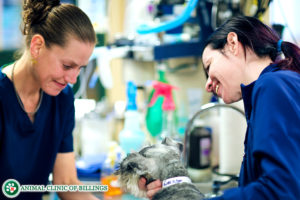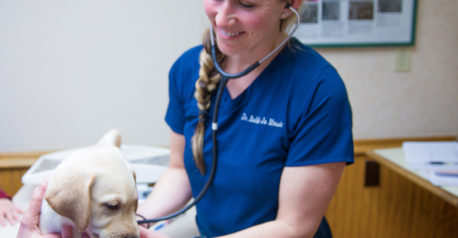exploratory arthroscopy with biopsy and fragment removal
What is veterinary exploratory arthroscopy with biopsy or fragment removal?
In dogs that present with lameness or joint problems that have unclear origins, a diagnosis must be made before the issue can be treated. If diagnostic imaging alone is inconclusive, exploratory surgery may be necessary. Arthroscopy is a type of surgery that is minimally invasive to the patient. It uses a small camera on the end of a probe to visualize the inside of the joint as opposed to physically opening up the joint to see inside.
This allows all of the components of the joint, including the cartilage, ligaments, meniscus and synovium, to be examined while they are illuminated and magnified. Once the severity of the joint damage has been determined, fragments or other tissue may be removed from the joint for further examination. In some instances, the joint may be treated during this process, while in others further care will be needed. Arthroscopy must be performed by a surgical arthroscopist who regularly deals with the complex equipment arthroscopy entails.
Exploratory Arthroscopy with Biopsy or Fragment Removal Surgery in Dogs
The veterinarian will perform a complete physical examination of the dog to assess how the joints are functioning. X-ray images or an ultrasound will be needed to determine if any fragments can be seen. If surgery is deemed appropriate, a full panel of blood work will be run on the dog. This can help in deciding whether the dog should receive general anesthesia or not. Prior to surgery, the affected leg will be clipped and disinfected. An IV will be inserted and sedatives will be administered.
Two or three small portal incisions will be made for the camera and various surgical tools to be inserted into the joint. An opening will be made in the joint to drain out all fluids. If any ligament tears are found, these can be removed. If this tissue is being sent to a lab for examination as a biopsy, it will be carefully harvested and contained. An assistant will be needed to move the leg into different positions as the surgeon performs the exploration. Any bone fragments found should also be removed. The joint should be thoroughly washed at the end of the operation to eliminate any remaining debris. Pain medication is often injected into the joint prior to closure. The incisions may be closed using sutures.
How safe is exploratory arthroscopy with biopsy or fragment retrieval in dogs or cats?
Exploratory arthroscopy with biopsy or fragment removal procedures are extremely safe when conducted by an experienced and arthroscopy certified veterinary orthopedic surgeon. With the use of exploratory arthroscopy, it is possible to identify and sometimes treat the causes of lameness in dogs. The procedure works far better in larger breeds of dogs due to their increased joint size. An arthroscopy is generally preferred over an arthrotomy, as the latter requires a large incision to be made in the animal. Arthroscopies are associated with faster recovery times and less pain, swelling, and potential damage to the joint tissues. A successful diagnosis is twice as likely to occur with the use of an arthroscopy. Exploratory surgery may often result in an excision or debridement procedure.
What to expect after Exploratory Arthroscopy with Biopsy or Fragment Retrieval surgery for your dog or cat
The dog or cat will need to be closely monitored as it wakes up from the general anesthesia. The surgical wounds will be bandaged using an aseptic wrap. A course of antibiotics will also likely be prescribed to help ward off bacterial infection in the joint. The dog or cat will need to be hospitalized for one to three days depending on the extent of the surgery. If the dog or cat will not leave the incision site alone, an Elizabethan collar may be needed. The wound area should be kept clean and watched for any signs of infection. A follow-up appointment with your veterinarian or veterinary orthopedic surgeon will be needed to remove any sutures and assess the healing of the joint. If any biopsies were sent for evaluation, the results should be in at this time. A treatment plan may begin if the results merit it. Physiotherapy will likely be needed to help restore movement in the affected joint.
Veterinary Exploratory Arthroscopy with Biopsy or Fragment Retrieval surgical procedure considerations
Any surgery that uses general anesthesia brings with it rare but serious risks. In surgeries of the joint, there is also the potential for the medial meniscus to be injured. If the CCL is torn, a further procedure known as a tibial plateau leveling osteotomy (TPLO) may be needed. If a meniscal release is performed during the exploratory arthroscopy, the risk of ligament tears goes down. The cosmetic results from an arthroscopy are far better than those of an arthrotomy.
How to prevent exploratory arthroscopy with biopsy or fragment removal surgery on your dog or cat
Many issues that lead to joint problems are inherited genetically. It is of the utmost importance to obtain a full family health history when buying a new puppy to identify potential health problems to watch for. Injuries can also lead to damaged joints. These are often repetitive injuries caused by activities such as jumping up onto things, or from vigorous play. Controlled exercise and leashed walks can decrease the chance of your dog developing joint injuries that require surgery to correct.

Let our highly trained and experienced team of veterinarians and veterinary technicians help you keep your cat as happy and healthy as they can be.
Call the Animal Clinic of Billings and Animal Surgery Clinic to schedule your pet cat’s next wellness examination with one of our veterinarians today!
406-252-9499 REQUEST AN APPOINTMENT
ANIMAL CLINIC OF BILLINGS AND ANIMAL SURGERY CLINIC
providing our region’s companion animals and their families what they need and deserve since 1981
1414 10th St. West, Billings MT 59102
406-252-9499



